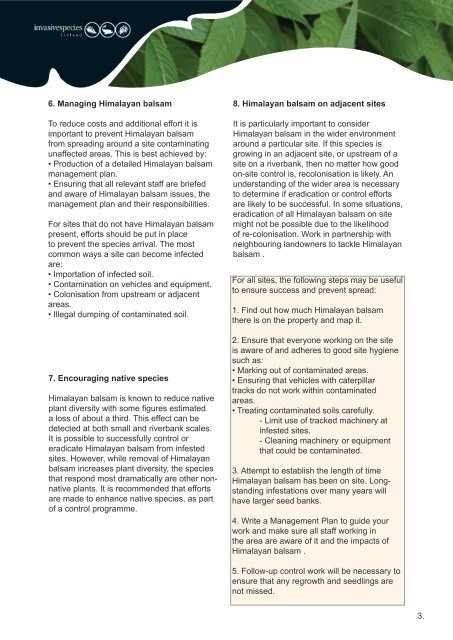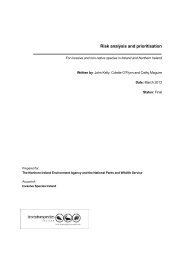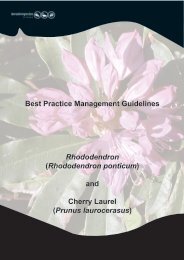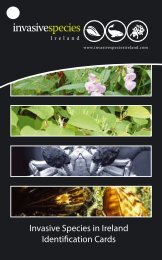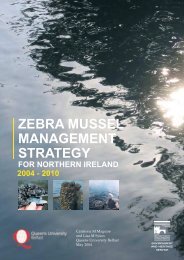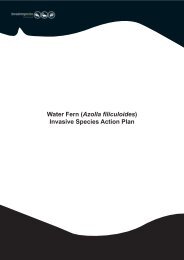Best Practice Management Guidelines Himalayan balsam - Invasive ...
Best Practice Management Guidelines Himalayan balsam - Invasive ...
Best Practice Management Guidelines Himalayan balsam - Invasive ...
You also want an ePaper? Increase the reach of your titles
YUMPU automatically turns print PDFs into web optimized ePapers that Google loves.
6. Managing <strong>Himalayan</strong> <strong>balsam</strong><br />
To reduce costs and additional effort it is<br />
important to prevent <strong>Himalayan</strong> <strong>balsam</strong><br />
from spreading around a site contaminating<br />
unaffected areas. This is best achieved by:<br />
• Production of a detailed <strong>Himalayan</strong> <strong>balsam</strong><br />
management plan.<br />
• Ensuring that all relevant staff are briefed<br />
and aware of <strong>Himalayan</strong> <strong>balsam</strong> issues, the<br />
management plan and their responsibilities.<br />
For sites that do not have <strong>Himalayan</strong> <strong>balsam</strong><br />
present, efforts should be put in place<br />
to prevent the species arrival. The most<br />
common ways a site can become infected<br />
are:<br />
• Importation of infected soil.<br />
• Contamination on vehicles and equipment.<br />
• Colonisation from upstream or adjacent<br />
areas.<br />
• Illegal dumping of contaminated soil.<br />
7. Encouraging native species<br />
<strong>Himalayan</strong> <strong>balsam</strong> is known to reduce native<br />
plant diversity with some figures estimated<br />
a loss of about a third. This effect can be<br />
detected at both small and riverbank scales.<br />
It is possible to successfully control or<br />
eradicate <strong>Himalayan</strong> <strong>balsam</strong> from infested<br />
sites. However, while removal of <strong>Himalayan</strong><br />
<strong>balsam</strong> increases plant diversity, the species<br />
that respond most dramatically are other nonnative<br />
plants. It is recommended that efforts<br />
are made to enhance native species, as part<br />
of a control programme.<br />
8. <strong>Himalayan</strong> <strong>balsam</strong> on adjacent sites<br />
It is particularly important to consider<br />
<strong>Himalayan</strong> <strong>balsam</strong> in the wider environment<br />
around a particular site. If this species is<br />
growing in an adjacent site, or upstream of a<br />
site on a riverbank, then no matter how good<br />
on-site control is, recolonisation is likely. An<br />
understanding of the wider area is necessary<br />
to determine if eradication or control efforts<br />
are likely to be successful. In some situations,<br />
eradication of all <strong>Himalayan</strong> <strong>balsam</strong> on site<br />
might not be possible due to the likelihood<br />
of re-colonisation. Work in partnership with<br />
neighbouring landowners to tackle <strong>Himalayan</strong><br />
<strong>balsam</strong> .<br />
For all sites, the following steps may be useful<br />
to ensure success and prevent spread:<br />
1. Find out how much <strong>Himalayan</strong> <strong>balsam</strong><br />
there is on the property and map it.<br />
2. Ensure that everyone working on the site<br />
is aware of and adheres to good site hygiene<br />
such as:<br />
• Marking out of contaminated areas.<br />
• Ensuring that vehicles with caterpillar<br />
tracks do not work within contaminated<br />
areas.<br />
• Treating contaminated soils carefully.<br />
- Limit use of tracked machinery at<br />
infested sites.<br />
- Cleaning machinery or equipment<br />
that could be contaminated.<br />
3. Attempt to establish the length of time<br />
<strong>Himalayan</strong> <strong>balsam</strong> has been on site. Longstanding<br />
infestations over many years will<br />
have larger seed banks.<br />
4. Write a <strong>Management</strong> Plan to guide your<br />
work and make sure all staff working in<br />
the area are aware of it and the impacts of<br />
<strong>Himalayan</strong> <strong>balsam</strong> .<br />
5. Follow-up control work will be necessary to<br />
ensure that any regrowth and seedlings are<br />
not missed.<br />
3.


